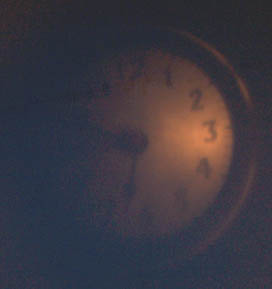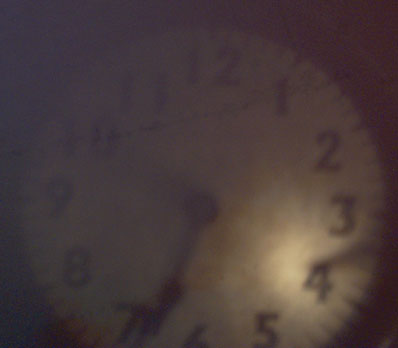It's a good idea to set the hands
to 12:00 on both dials during installation of the hands.
Trying to read the flipped dial can lead to the two clocks not
telling the same time.
The minute hand on the daylight dial has a radius that's bigger
than the metal ring that holds the glass. So the metal ring
(and optionally the glass) needs to be removed and installed with
the clock work, not separately since that would bend the minute
hand unless you can "spring" the ring or get it off center enough
to clear the hand.
This clock has the lens, but is
missing the two lamp holder assemblies and the winding/setting
extension that's accessible when the lens tube is pulled
off. The wire insulation is completely missing in
spots. A prior owner has tack nailed a wooden block in the
battery compartment to allow the use of three "D" cells as the
power source and included a drawing of their arrangement.
812105 Advertizing Projecting
Apparatus, FEKDINAND WETZLEE, Feb 6, 1906,
368/76 ;
368/227- projects time and ad
813836 Shadow-Clock, RICHARD BARTHOLOMEW SMITH, Feb 27 1906,
368/79
; 40/560 - projects both time and advertisements
1097310 Automatic Annunciator, Genter, Jun 19 1914,
368/223
; 368/238 - projects slides & time
1137512 Advertizing Clock , H. MILLER Apr 27 1915,
353/40
; 368/223- project time and advertising message
1147501 Automatic Annunciator, Genter, Jul 20, 1915,
368/234
; 362/268 - projects slides & time
1172844 Stereoptican Advertixing Clock, ABRAHAM STEINBERG (Kineto
Machine Co), Feb 22, 1916,
368/234 - projects time and
ads
1275791 Clock Mechanism, Thereault, Aug 13 1918,
368/42 ;
40/474; 40/496; 968/384 - projects time and changes dial images
1579880 Shadow Projecting Apparatus, Meissner, Apr 6 1926,
368/79
- for use outdoors or in a large indoor room
1667210 Advertizing Device, KARL OSCAB LEON, Apr 24, 1928,
368/67
- the ads don't conflict with the time display
1913870 Advertizing and the Like Device, G. BRIGGS, Jun 13, 1933,
368/41 ; 353/110 - rear projection system with film strip
of ads and clock
1938417 Clock Illuminating Mechanism, Joseph C. Curran, Dec 5,
1933,
368/79 ; 116/DIG.29; 116/DIG.36; 368/234; 40/444;
968/490 - uses 12 lamps
2150036 Clock, J. J. PARIS, Mar 7, 1939,
368/79 ; 246/1C;
968/216 - alarm clock turns on projected ceiling image when alarm
rings
2201376 Clock, Leendert Prins, May 21 1940,
368/79 ;
968/216 -
2243759 Clock, Joseph Maluo, May 27, 1941,
368/220 ;
968/216; D10/126 - designed to be used with conventional projector
2290811 Projector for Time Indications, Nassoit, Jul 21 1942,
368/76
; 353/40; 368/227; 968/216 - single film strip moves once per
minute
2351238 Display Device, Max M. Teuber, Jun 13 1944,
368/223
; 40/560 - projects both time and ads
2486425
Watch Dial Projecting Device using Reflected Light, S.
Loewe, Nov 1 1949,
353/40 ; 362/26; 368/227-
References:
813836 see above
835431Projector for Pathalogical Work, Nov 6, 1906, Nov 6, 1906,
353/66 - reflected light projector
1074260 Device for Projecting Images of Temperature Indicators,
GEORGE M. GUEBBANT, Sep 30, 1913,
353/40 ; 33/355R -
lamp, collimator, needle pointer
and projection lens
1616747 Picture Projecting Device, AUBREY DE VERB HARNETT, Feb 8
1927,
353/66 -
images arranged around the edge
of a book with text in the center. Projector moved
around edge
2201376 Clock, Leendert Prins, May 21 1940,
368/79 ;
968/216 - very similar to my projection clock in layout, except
has reflector
2351238 see above
2502985 Clock, Bernard J. Paulson, Apr 4 1950,
368/79 ;
116/286; 116/DIG.6; 368/234; 968/213-
a rear projection clock where the
hour digits and minute hand is projected onto it's face
Calls:
1887479 Illuminated Clock - clock with light- not projection
1950189 Timepiece - different time zones- not projection
2009209 Illuminated Measuring Device - edge lit hands - not
projection
2380171 Time Indicating Mechanism - rear projection of hour
digits
2652745 Direct Reading Projection Clock Apparatus, Francis J.
Quinn, Sep 22 1953,
368/79 ; 352/126; 352/97; 353/35;
40/472; 968/216-
uses two loops of movie film, one
with the hours and the other with the minutes
Calls:
1097310 Automatic Annunciator, Genter
1147501 Automatic Annunciator, Genter
1290947 Advertizing Projecting Device - film strip projector,
not clock
1523767 Means for Displaying Quotations or the like - an opaque
projector, not clock
1479880 ?
1580286 Station Indicator - in railway cars film strip
projector, not clock
2025361 Advertizing Device - film strip projector
2078936 Stock Quotation Projecting Machine - opaque projector
not clock
2351238 Display Device, Max M. Teuber
2694338 Clock Face Projecting Device, Isaac Moultry, Nov 16 1954,
368/69 ; 353/85; 968/216 -
has remote push button switch to
turn on the lamp
Calls:
740433 Night Light, Friedrich Hirth, Oct 6 1903
778891 Magic Lantern w/electric lamp - not clock
813836 Shadow-Clock, RICHARD BARTHOLOMEW SMITH
1032160 Station Indicating Device for the outside sign on street
cars - not clock
1137512 Advertizing Clock , H. MILLER
1153110 View-Changind Device - film strip projector with remote
advance button - not clock
1292005 Projector - a collimated light source to which a camera
is attached making a projector, not clock
1992776 Projector - for childern's viewgraph disks - not clock
2201376 Clock, Leendert Prins
2351238 Display Device, Max M. Teuber
2486425 Watch Dial Projecting Device using Reflected Light,
S. Loewe
2726571 Shadow Image Clock Projecting Device, Henry K. Chang, Dec
13 1955,
368/79 ; 40/560; 968/216 -
Calls:
457694 Magic Lantern uses clockwork to time projection of ads
and train stations
812105 Advertizing Projecting Apparatus, FEKDINAND WETZLEE
813836 Shadow-Clock, RICHARD BARTHOLOMEW SMITH
877041 Projection Apparatus for opaque or transparent subjects -
not clock
1053650 Exhibition Device for stereoptican images - not clock
1172844 Stereoptican Advertizing Clock, ABRAHAM STEINBERG
(Kineto Machine Co)
1913870 Advertizing and the Like Device, G. BRIGGS
2195425 Projector, Opaque - not clock
2201376 Clock, Leendert Prins
2351238 Display Device, Max M. Teuber
2834250 Projecting Clocks Provided with Rotating Dials, E.
STEFANI, May 13 1958,
368/234 ; 235/61PK; 353/40; 40/560;
968/216 -
projects only an analog hour dial,
designed to be built into furniture
Calls:
1619096 rear projection of ads - not clock
2191045 Speed Indicator for cars - not clock
2351238 Display Device, Max M. Teuber
2471800 Shadow Image Projection Indicating Apparatus - an
electrical meter - not clock
2486425 Watch Dial Projecting Device using Reflected Light,
S. Loewe
2579806 Projecting Speed Indicator - car speedometer - not clock
2641159 Vehicle Indicator Optical Projection Device - car
speedometer - not clock
2641160 Vehicle Indicator Optical Projection Device - car
speedometer - not clock
2694338 Clock Face Projecting Device, Isaac Moultry
2875668 Projector for Time Indications, G. Stuart Mckenzie, Mar 3
1959,
368/76 ; 368/227; 40/472; 968/216 -
analog line powered clock has two
film strips, one for hours and one for minutes both expressed in
digits his and hers light buttons
Calls:
1147501 Automatic Annunciator, JACOB H. GENTER
2078936 Stock Quotation Projecting Machine - opaque projector
not clock
2425704 Power Driven Intermittent Strip Film Mechanism -
not clock
2486425 Watch Dial Projecting Device using Reflected Light,
S. Loewe
2652745 Direct Reading Projection Clock Apparatus, Francis J.
Quinn
2834250 Projecting Clocks Provided with Rotating Dials, E.
STEFANI
3136210 Apparatus for Shadow Projection of Clock Dial, Charles A.
Barrett, Jun 9 1964,
368/79 ; 353/40; 353/85; 968/216
dial pivots so it can be
positioned facing out for normal reading or facing light
source for projection, Calls:
740433 Night Light, Friedrich Hirth, Oct 6 1903
1578607 Watch - looks like a folding travel clock - not
projection
1645633 Watch - looks like a folding travel clock - not
projection
2243759 Clock, Joseph Maluo
2358422 Combined Bed Reading Lamp and Clock - not projection
2694338 Clock Face Projecting Device, Isaac Moultry
2726571 Shadow Image Clock Projecting Device, Henry K. Chang
2834250 Projecting Clocks Provided with Rotating Dials, E.
STEFANI
3179003 Horologe with Time Indication Projected on Screen, Clement
R. Toinpson (Zenith Radio Corp), Apr 20, 1965,
368/79 ; 116/DIG.29;
368/227; 368/234; 968/216; D14/170-
projected hour digits in
clock radio conventional azimuth minutes indication.
Calls:
1275791 Clock Mechanism, Thereault
2040421 Numeral Clock - flipping card type - not projection
2886942 Indicating Device for Watches - not projection
339220 Night-Clock, Apr 6, 1886,
368/67 ; 362/29 - clock
drives glass cylinder with candle in center
3620004 Time Indicating Device of the Direct Read-off type, F. H.
MARZ (Bunker-Ramo Corp), Nov 16 1971,
368/224 ; 368/185;
368/228; 968/216-
Filmstrip projector which advances
once a minute. Continous loop of fild good for 12 or 24
hours at one frame per minute
Calls:
2652745 Direct Reading Projection Clock Apparatus, Francis J.
Quinn
1667210 Advertizing Device, KARL OSCAB LEON
3673787 Digital Clock Mechanism, Radoslav Kovacevic, Jul 4 1972,
368/79
; 353/40; 353/74; 368/220; 968/216; 968/553; 968/577
a rear projection clock showing
hh:mm:ss based on an analog clock using gears
Calls:
1218607 Stereoptican Advertizing Clock, GEORGE WILLENS, Mar 6,
1917, 368/124 ; 368/234 -
1137512 Advertizing Clock , H. MILLER
2351238 Display Device, Max M. Teuber
2486425 Watch Dial Projecting Device using Reflected Light,
S. Loewe
2694338 Clock Face Projecting Device, Isaac Moultry
2834250 Projecting Clocks Provided with Rotating Dials, E.
STEFANI
3136210 Apparatus for Shadow Projection of Clock Dial, Charles
A. Barrett
3179003 Horologe with Time Indication Projected on Screen,
Clement R. Toinpson (Zenith Radio Corp)
2875668 Projector for Time Indications, G. Stuart Mckenzie
3439492 Chromoclock, G. F. GRAVENSON - not clock random color
generator
2875668 Projector for Time Indications, G. Stuart Mckenzie
3783603 Time Indication, Paul Himmelsbach, Jan 8 1974,
368/82
; 368/234; 968/216 -
uses two overlapping disks to
project HH and MM, can be 24 hours. Rear projection.
Calls:
3673787 Digital Clock Mechanism, Radoslav Kovacevic
2502985 Clock, Bernard J. Paulson
2834250 Projecting Clocks Provided with Rotating Dials, E.
STEFANI
3179003 Horologe with Time Indication Projected on Screen,
Clement R. Toinpson (Zenith Radio Corp)
D345308 Design for Clock, Hiromi Kanai, Mar 22 1994,
D10/26
Calls:
740433 Night Light, Friedrich Hirth, Oct 6 1903
813836 Shadow-Clock, RICHARD BARTHOLOMEW SMITH
2290811 Projector for Time Indications, Nassoit
2486425 Watch Dial Projecting Device using Reflected Light,
S. Loewe
2652745 Direct Reading Projection Clock Apparatus, Francis J.
Quinn
2726571 Shadow Image Clock Projecting Device, Henry K. Chang
2875668 Projector for Time Indications, G. Stuart Mckenzie
3136210 Apparatus for Shadow Projection of Clock Dial, Charles
A. Barrett
5143442
Portable
projection device, Masaaki
Ishikawa, Masao
Yamada, Sep 1, 1992, 362/253, 362/800, 362/184, 362/205, 362/196, 362/208
LED light source and either fixed slide or LCD
clock.
Other Patents
693953 Geographical Clock, Charles E. Davis , Feb 25 1902,
368/27
; 180/90; 362/29 -
24 hour clock showing light and
dark with city names
700496 Electric Time Alarm, Conrad Hubert, May 20 1902,
368/259
; 200/35R; 315/360; 362/253; 368/256 -
700497 Electric Battery, Conrad Hubert, May 20 1902,
429/133
; 439/816 -
a cylindrical cell with a metal
ring at the top so that both contacts are on the same end.
The Electric Time Alarm uses three of them each in a wooden
compartment with two springs to make contact.
704446 Watch Dial Illuminator, Frederick M. Durkee, Jul 8, 1902,
368/277
; 362/23; 368/223 - cylinder holds battery, hangs on wall with
flashlight bulb above watch, when button at end of cord is pressed
you can see watch. Button looks the same as this one.
815072 Electric Alarm Clock, Augusta Y. Darche, Mar 13, 1906,
368/258
- uses first generation
No. 6 dry cell
and stand D37091.
D37091 Stand for Portable Electric Alarm Clocks, Augusta Y.
Darche, Aug 16 1904,
D10/128 ; D10/1; D10/23 -
2466312 Transparent Disk Clock, Ralph M. Heintz, Apr 5 1949,
368/77
; 368/234; 968/395 -
transparent disks for hours,
minutes and 1 to 12.
712112 Illuminated Watch Box, CAROLUS ARNOLD, Oct 28 1902,
362/155
; 132/288; 362/109; 368/276 -
Box with light in lid, battery in
bottom and switch connected with the latch button
721205 Electric Time Switch, ALBERT W. LAUTER, Feb 24, 1903, -
when alarm clock goes off it turns
on a flashlight lamp in front of the clock.
740433 Night Light, Friedrich Hirth, Oct 6 1903 (see above)
750787 Clock Case, Aaron D. Blodget, Jan 26, 1904,
368/291
; 362/30 - Illuminated Tower Clock
835762 Watch Stand, M. Koller, Nov 13 1906,
368/316 ;
362/23 - a stand allows a watch to hand and avove is a pocket
flash light
1101429 Automatic Annunciator, Genter, May 1914,
368/223 ;
362/268; 362/293; 362/308; 362/812; 368/238; 40/473 -
projects time & ads (see
above)
1106807 Pendulum Lamp for Clocks, CHRISTIAN B. HANSON, Aug 11,
1914,
368/67 ; 362/234; 368/88 -
pendulum has a constant burning
lamp and the clock has lamps that blink in beat with the
pendulum.
1135228 Clock, Leverett F. Viner, Apr 13, 1915,
368/88 ;
116/286; 362/29; 968/213 - backlighted dial for clock in floor
1233559 Reminder Clock, Augusta Y. Darche, Jul 17, 1917,
200/37R
; 368/250 - a pin is inserted ( 15 minute steps) to set alarm time
1271735 Illuminated Watch Holder, BENJAMIN F. LOCKWOOD, Jul 9
1918,
362/103 ; 116/DIG.36; 362/23; 368/10- on the back of
a glove
1515135 Illuminated Globe, A. S. ALEXANDER, Nov 11 1924,
434/143
; 362/269; 368/24; 434/145; D26/94 -
Not just day and night, but also
season of the year (manual setting)
1656029 Advertizing Device, G. WILLENS, Jan 10, 1928,
40/575
; 362/23; 368/227; 40/716; 40/728; 968/216; 968/393 -
clock hands are projected as
shadows (no expensive lens) and ad in paper form in window.
1750505 Astronomical Clock, M.N. Bulka, Mar 11 1930,
368/16
; 362/132; 362/809; 368/37; 434/293 -
Shows relationship between Earth,
Moon and Sun using a lamp and gears
1760253 Advertizing Clock Dial and Means of Illuminating the same,
Parrish, May 27 1930,
40/546 ; 180/90;
246/1C; 362/29; 368/232; 368/239; 968/213; 968/392 - radium
painted clock hands are illuminated by a nearby light which is
filtered - use in theaters
1959601 Chronological Instrument, Herman E. Schulse (Uniclox
Corp), May 22 1934,
368/24 ; 362/809; 368/185; 368/28;
434/143; 434/145; 968/178; 968/210; D19/61 - illuminated globe
that tracks both time and date.
1994950 Illuminated Dial, Charles William Hoffritx, Mar 19 1935,
362/23
; 362/216; 368/226; 368/232; 968/213- hidden Neon tube illuminated
hands and numbers on black dial
2045798 Combined Alarm Clock and Light, Purvis, Jun 30 1936,
368/256
; 362/253; 968/613- uses line powered lamp
2099518 Globe Chronomoter, G. W. Haslett, Nov 16, 1937,
368/24
; 362/809; 434/142; 968/169 -
displays time but not sun's shadow
or effect of seasons
page created 12 Jan 2008.
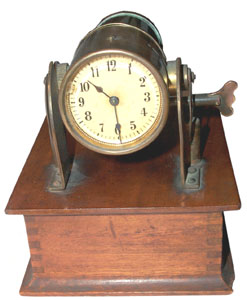





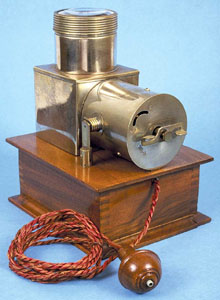
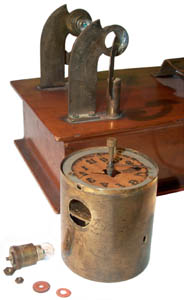

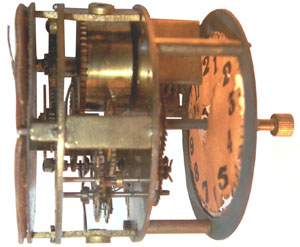
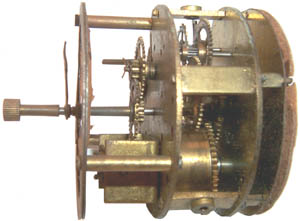
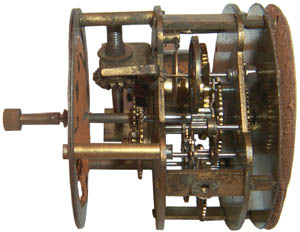

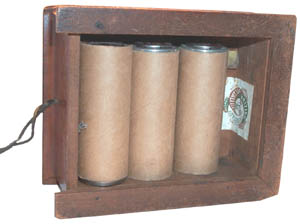
 Fig 15 Time
Savers No. 13427 KD type Hand Puller
Fig 15 Time
Savers No. 13427 KD type Hand Puller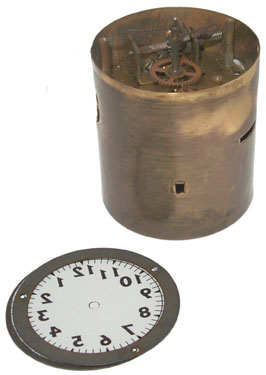 Fig 16 This is a new projection clock
dial. The three attachment screws are on an isosceles triangle, not
an equilateral triangle and none of them is at a cardinal clock
point. Photo shows clock and dial in correct relative
orientation.
Fig 16 This is a new projection clock
dial. The three attachment screws are on an isosceles triangle, not
an equilateral triangle and none of them is at a cardinal clock
point. Photo shows clock and dial in correct relative
orientation. Fig 17
This is a pair of 20 AWG wires (10 strands each 0.010" dia)
covered with gold Rayon.
Fig 17
This is a pair of 20 AWG wires (10 strands each 0.010" dia)
covered with gold Rayon.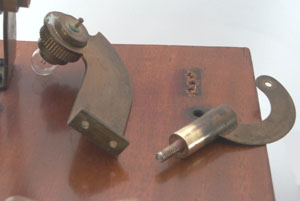 Fig
18 After assembly of the new projection dial I'd
like to just see how it looks on the ceiling. But when
voltage is applied to the wires no light. The problem is
the joint between the bare copper wire and the lamp
holder. It's attached to the wooden base using two screws
and the wire is just set under the bracket. You can just
see the wire in the photo at the left where it comes up through
the center hole and runs to the screw hole closest to the
camera. With time the wood shrinks or the screws loosen
and contact is lost. There's another indentation in the
wood where previously the wire was curled in a circle and that
most have also lost contact.
Fig
18 After assembly of the new projection dial I'd
like to just see how it looks on the ceiling. But when
voltage is applied to the wires no light. The problem is
the joint between the bare copper wire and the lamp
holder. It's attached to the wooden base using two screws
and the wire is just set under the bracket. You can just
see the wire in the photo at the left where it comes up through
the center hole and runs to the screw hole closest to the
camera. With time the wood shrinks or the screws loosen
and contact is lost. There's another indentation in the
wood where previously the wire was curled in a circle and that
most have also lost contact.